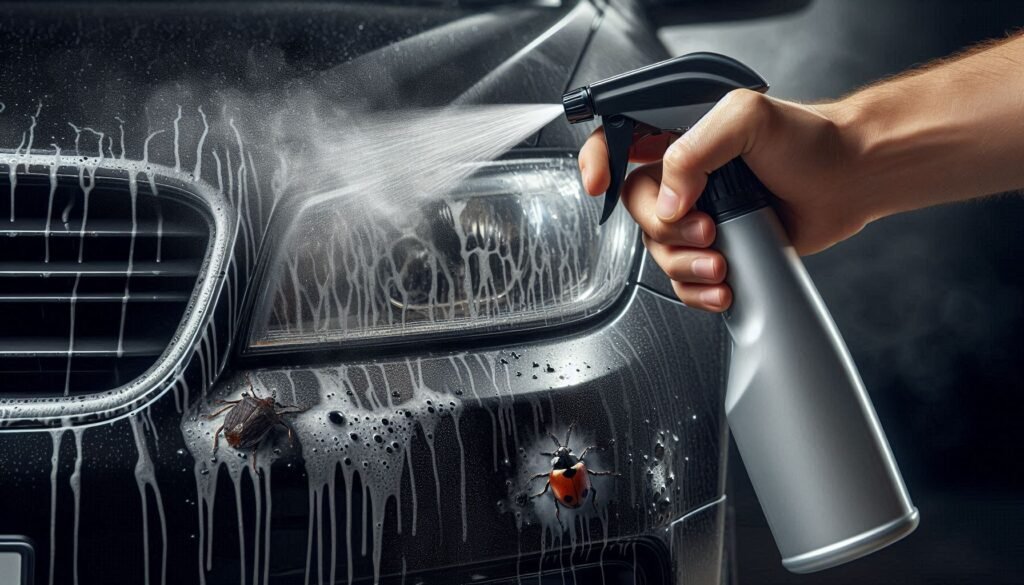How to Safely and Effectively Remove Tar and Bugs from Your Car’s Exterior Using Chemical Cleaners

By Ali Hasan Omar | October 8, 2024
Introduction
Maintaining your car’s exterior can be challenging, especially when stubborn tar and bug splatter accumulate on the surface. These contaminants not only ruin the sleek appearance of your vehicle but can also damage the paint over time if not properly cleaned. The good news is that, with the right approach and using specialized chemical cleaners, you can restore your car’s shine without harming its finish.
In this guide, we’ll walk you through the detailed steps to safely remove tar and bugs from your car’s exterior, while offering additional tips to keep your vehicle in top condition.
Why Tar and Bugs are Harmful to Your Car’s Paint
When bugs hit your car at high speeds, their acidic bodily fluids can etch into the paint if left unattended. Tar, on the other hand, is sticky and difficult to remove, often trapping dirt and debris, which can also damage the clear coat and paint underneath. Ignoring these contaminants not only dulls your vehicle’s appearance but also increases the risk of long-term paint deterioration.
The Role of Chemical Cleaners
While you might be tempted to use household cleaners or rely on soap and water, these aren’t effective enough for tough grime like tar and bugs. Automotive chemical cleaners are specifically designed to break down sticky and hard residues without damaging your car’s clear coat or paint. These cleaners contain ingredients that dissolve the contaminants, allowing them to be wiped away with ease.
What to Look for in a Quality Tar and Bug Remover
When choosing a chemical cleaner, consider the following factors to ensure the product is safe and effective for your car:
- Clear Coat Safety: Always select a product that’s marked as safe for clear coats and automotive paint.
- Ease of Use: Look for spray formulas that are easy to apply and come with clear instructions.
- Added Protection: Some cleaners provide an added layer of protection by leaving behind a sealant that prevents future buildup.
- Reputation and Reviews: Opt for brands known for quality and positive feedback.
Step-by-Step Guide to Removing Tar and Bugs from Your Car
Step 1 – Choose the Right Cleaner
Not all cleaners are the same. Choose a tar and bug remover specifically formulated for automotive use.
Step 2 – Pre-Rinse the Area

Before applying any chemical cleaner, start by rinsing the affected area with clean water. This helps to:
- Remove loose dirt, dust, and debris that could scratch the paint when wiped.
- Soften up the tar and bug spots for easier cleaning.
Use a hose or a pressure washer on a gentle setting to pre-rinse the area.
Step 3 – Apply the Chemical Cleaner

- Follow the instructions on the cleaner’s label for the correct amount of product to use.
- Allow the cleaner to sit on the surface for 1–2 minutes. This dwell time is crucial as it lets the cleaner penetrate and break down the adhesive properties of the contaminants.
If you’re dealing with larger areas, work in sections to prevent the cleaner from drying out before you have a chance to wipe it away.
Step 4 – Gently Wipe Away the Residue

Using a high-quality microfiber cloth or soft sponge, gently wipe away the dissolved tar and bugs. Here’s how to do it right:
- Use gentle, circular motions to avoid creating swirl marks on the paint.
- Avoid scrubbing too hard, especially on delicate areas, as this can scratch the surface.
- For stubborn spots, reapply the cleaner and give it additional time to break down the grime. Repeat as necessary.
Step 5 – Rinse Thoroughly

Once the tar and bugs have been removed, rinse the area again with clean water. This step ensures that no chemical residue is left behind, which could otherwise affect the paint or clear coat over time.
Step 6 – Apply a Protective Wax or Sealant
After cleaning the surface, it’s a good idea to apply a coat of wax or sealant to the area. This provides several benefits:
- Seals the paint: Wax creates a protective barrier, preventing contaminants like tar, bugs, and dirt from sticking as easily.
- Easier future cleaning: When the car’s surface is sealed, tar and bugs will come off with less effort next time.
- Shines and protects: Wax also gives your car a brilliant shine and protects it from environmental factors like UV rays, bird droppings, and road grime.
Additional Tips for Best Results
- Work in the Shade: Direct sunlight can cause the chemical cleaner to dry too quickly, making it less effective and potentially damaging the paint.
- Test in a Small Area: Before applying the cleaner to the entire affected area, test it on a small, inconspicuous spot to ensure it won’t harm your paint.
- Use a Soft-Bristled Brush for Tough Spots: If some grime proves especially stubborn, use a soft-bristled brush to gently agitate the area. Avoid using anything abrasive that could scratch your car’s surface.
- Reapply as Needed: For particularly tough tar or bug spots, you may need to repeat the cleaning process multiple times. Be patient and let the cleaner do its job without aggressive scrubbing.
Why Regular Maintenance is Key
Removing tar and bugs regularly prevents long-term damage to your car’s paint and keeps it looking new. By including this task in your regular car washing routine, you’ll avoid the buildup of contaminants that can eventually lead to costly repairs or repainting.
Conclusion
Using the right chemical cleaner, combined with the correct technique, is the most effective way to remove tar and bugs from your car’s exterior. Not only does it restore your car’s shine, but it also protects the paint from damage and keeps your vehicle in top condition. With a little effort and the right products, you can maintain your car’s appearance and ensure it always looks its best.
Remember: Clean, rinse, protect, and enjoy the lasting beauty of your vehicle!
FAQs
Why is it important to remove tar and bugs from my car’s exterior?
Leaving tar and bugs on your car's surface can lead to long-term damage. Bug splatter contains acids that can eat into your car’s paint, while tar can harden and trap dirt, potentially scratching the clear coat. Promptly removing these contaminants helps maintain your car’s appearance and protects the paint from etching or damage.
What happens if I don't remove tar and bugs from my car?
If left untreated, tar and bug residue can harden and become even more difficult to remove. Over time, the acids in bug remains may corrode the paint, while hardened tar can cause scratches or chips. This damage not only affects your car’s aesthetics but could lead to costly repairs or repainting.
Can I use household cleaners to remove tar and bugs from my car?
Household cleaners are not recommended for removing tar and bugs from your car. Many contain harsh chemicals that can strip away the clear coat, damage the paint, or leave behind residue. It's best to use chemical cleaners specifically designed for automotive surfaces, which are formulated to dissolve contaminants without harming the paint.
What should I look for in a good tar and bug remover?
Choose a product designed for automotive use that is safe for clear coats and paint. Look for one that offers deep cleaning power, like FÖRCH Silicone Remover R507, which effectively breaks down tar, bugs, and silicone. Some products also provide added protection by prepping the surface for wax or sealant application.
How often should I remove tar and bugs from my car?
It’s ideal to remove tar and bugs from your car as soon as you notice them. For regular maintenance, inspect your car after long drives or trips on highways where bugs and tar are more likely to accumulate. Including tar and bug removal in your routine car wash is recommended to prevent buildup.
Can removing tar and bugs damage my car’s paint?
If done incorrectly, scrubbing too hard or using abrasive materials can damage the paint. To avoid this, use a microfiber cloth or a soft sponge, and apply a chemical cleaner specifically formulated for tar and bug removal. Follow the manufacturer’s instructions and gently wipe away residue to protect your car’s finish.
What tools do I need to safely remove tar and bugs from my car?
For effective tar and bug removal, you'll need:
- A chemical cleaner designed for automotive use
- A microfiber cloth or soft sponge
- A spray bottle (if the cleaner isn’t sprayable)
- A hose or bucket of water for rinsing
- Optionally, a soft-bristled brush for stubborn spots
- Wax or paint sealant for post-cleaning protection
Can I remove tar and bugs from my car without chemicals?
While soap and water may remove light dirt, tar and bugs often require something stronger. However, if you prefer chemical-free methods, you could try using a clay bar, which physically removes contaminants. Keep in mind that clay bars may not be as effective on deeply embedded grime, and you may need to follow up with a proper cleaner.
What’s the best way to prevent tar and bugs from sticking to my car?
Applying a protective wax or sealant after cleaning can help prevent tar and bugs from bonding to your car’s surface. These products create a smooth, protective layer that makes it easier to wipe away future contaminants. Additionally, using a paint protection film (PPF) on vulnerable areas like the front bumper can also minimize the buildup of debris.
How long should I let the chemical cleaner sit before wiping it off?
Most chemical cleaners require 1–2 minutes to break down tar and bugs effectively. Follow the instructions on the product label to ensure you give the cleaner enough time to work. Avoid letting the cleaner dry on the surface, as this can make it harder to remove.
Can I remove tar and bugs in direct sunlight?
It’s best to work in a shaded area when removing tar and bugs from your car. Direct sunlight can cause the cleaner to dry too quickly, reducing its effectiveness and potentially leaving residue on the paint. Cleaning in the shade allows the product to work properly and prevents streaks.
Do I need to wax my car after removing tar and bugs?
Yes, it’s highly recommended to apply a coat of wax or paint sealant after cleaning. Wax not only restores shine but also creates a protective barrier against future contaminants. This makes it easier to remove tar and bugs next time, while also providing UV protection and keeping your paint in top condition.







